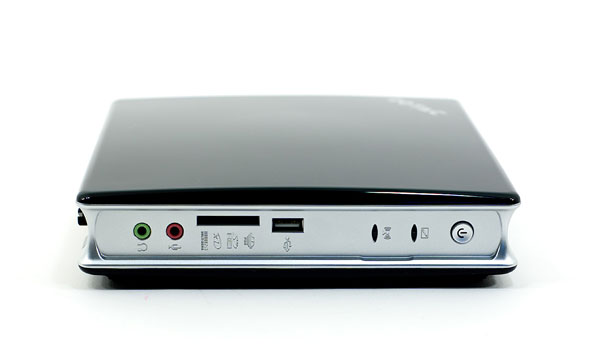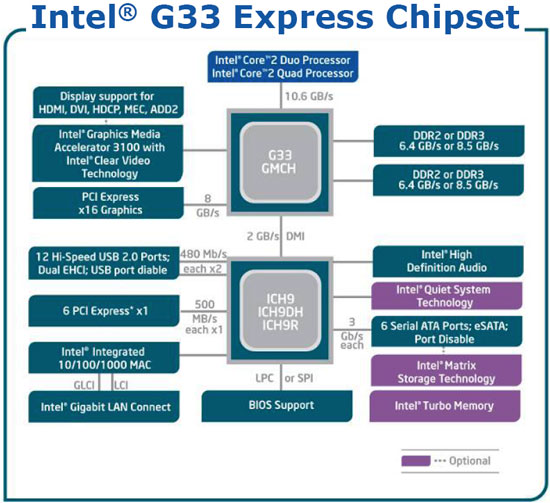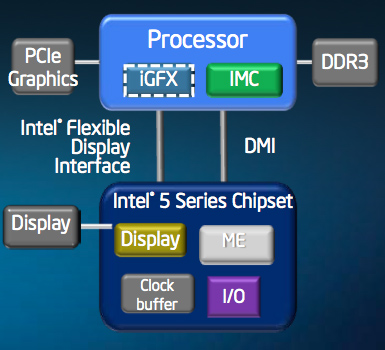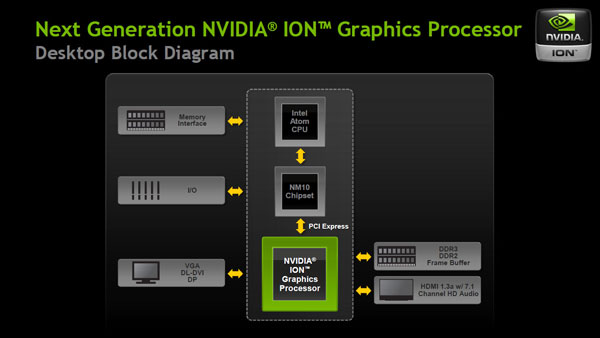Zotac ZBOX HD-ID11 Review: Next Gen ION is Better & Worse than ION1
by Anand Lal Shimpi on May 6, 2010 3:51 PM EST- Posted in
- GPUs
- Next Generation ION
- HD-ID11
- ZOTAC
- NVIDIA
The nForce 2 was one of the best chipsets to come out of NVIDIA. It was NVIDIA’s second attempt at a desktop chipset yet it cemented NVIDIA’s position as a leading provider of core logic in the market. Oh how much has changed since then.
Most of what made a chipset worthwhile is now integrated into the CPU. It used to be memory controller optimizations that kept chipsets afloat, but that’s no longer the case as all x86 processors now ship with an integrated memory controller. The performance differences between chipsets disappeared and all that was left was testing, validation and drivers, also known as the boring, expensive and time consuming aspects of chipset development.
NVIDIA has mostly abandoned the chipset business, focusing on opportunistic wins where possible. The most obvious example is with ION, its chipset/GPU for Atom based systems.

Last year we played with a number of ION systems and motherboards and were generally impressed. The platform made for a powerful little HTPC. Today we’re able to bring you a hands on performance preview of the first Next Generation ION box we’ve laid our hands on: the Zotac ZBOX HD-ID11.
Terms of Ndearment
CPUs connect to the outside world using proprietary bus interfaces. AMD uses Hyper Transport, while Intel previously used the AGTL+ FSB. In order to build a device that hangs off of this interface you need a license to use it. This is just an IP license to let you integrate the circuitry you need to communicate over that bus onto your silicon. It’s pretty commonplace.
Over the years Intel would update its FSB (Front Side Bus) specification, and it would threaten its chipset partners with revoking their license to the new version of the FSB unless they cooperated. Intel and VIA had a disagreement over this years ago that ended in VIA threatening Intel with CPU patents and the two coming to terms later on.

The old way of doing things, FSB between the CPU and the GMCH, DMI between the GMCH and ICH.
With Nehalem, Intel moved away from a parallel bus interface and introduced QPI (Quick Path Interconnect). This is a very high bandwidth point to point protocol designed for high end servers, workstations and desktops. It’s used in the Nehalem and Gulftown based Core i7s. NVIDIA said it had no interest in pursuing a QPI based chipset, so the issue of licensing never came up.

The new way, QPI between the CPU and IOH. DMI between the IOH and ICH.
A much lower bandwidth interconnect called DMI (Direct Media Interface) would be used for mainstream Nehalem/Westmere derivatives (e.g. Core i3, Core i5, LGA-1156 Core i7). Intel had used this interconnect in the past to connect parts of its chipsets together, but now it would be used to connect the CPU to a chipset.

The other new way: DMI between the CPU and chipset.
With its own aspirations of getting into the GPU market, and no real need for NVIDIA’s allegiance, Intel enforced its license agreement and threatened a lawsuit if NVIDIA sold chipsets that used Intel’s DMI. NVIDIA argued that it was well within its rights to do so but didn’t want to risk it and stopped development on DMI chipsets pending the outcome of its lawsuit against Intel for violating the terms of the license agreement.
The ION Problem
While all of this was going on, Intel’s Atom platform started gaining momentum in netbooks and nettops. The netbook version of Atom used the old AGTL+ FSB to connect to its chipset, so NVIDIA could technically produce chipsets for it. Which is exactly what NVIDIA did. It was called ION (and later renamed to Atom + ION).
The latest version of Atom for netbooks/nettops, codenamed Pineview, integrates the memory controller and graphics core. Its only connection to the outside world is, you guessed it, a DMI link.

In a Pine Trail Atom system, the Pineview CPU connects to Intel’s NM10 Express chipset over this DMI link. With no license for DMI and no desire to push its luck, NVIDIA can’t offer a drop in replacement for the NM10 Express chipset.
Luckily, Intel’s NM10 Express Chipset includes four PCIe 1.0 lanes. A motherboard manufacturer could simply hang a low end, discrete GPU off of these PCIe lanes and you’d get a modern ION platform. And that’s what NVIDIA did for its Next Generation ION.
Meet NG-ION
NVIDIA’s Next Generation ION is a 40nm discrete GPU based on the GT218 core, it’s effectively the same GPU as a desktop GeForce 210 video card with some differing clock speeds. The nettop version uses 16 cores, while the netbook version uses 8 or 16 depending on the screen size.
While manufacturers can use all four PCIe 1.0 lanes coming off Intel’s NM10 Express chipset, most have chosen to use just one leaving the remaining lanes for things like WiFi. A single PCIe 1.0 lane can only provide 250MB/s of bandwidth in either direction, hardly enough for a modern GPU. It’s because of this limitation that the next-generation ION GPU could actually perform slower than the first ION.

As a discrete GPU, the NG-ION comes with its own frame buffer: up to 512MB of DDR3 on a nettop. You also get full H.264 video decode acceleration and support for 8-channel LPCM audio over HDMI out.















40 Comments
View All Comments
Shadowmaster625 - Friday, May 7, 2010 - link
Why would intel only give 4 pci express lanes? That's just retarded. Why would NVidia even mess with this atom? Why not just use the old atom? Its the same damn thing. Just do a LTB on the old atom. Nvidia should go BK for doing stupid crap like this.hpmoon - Friday, May 7, 2010 - link
Wow. So while we appreciate that Zotac sent an early review unit, they should have paid attention when most of us observed that it would be rather offensive to jack up the price a second time merely by gauging enthusiast interest. $209 --> $239 --> $259 = pissed off customers. Now that the reviews are eh, we're done with you. And it's gonna hit you hard when every reviewer bemoans how $260 is just the beginning, with $100 at a minimum in additional expense for the RAM and hard drive. For truth-in-advertising, let's get real: The HD-ID11 is just under $400.Moving along.
hemantha - Sunday, May 9, 2010 - link
From the power consumption page - "The XBMC Live image I installed doesn't seem to let the Atom cores underclock themselves to 600MHz". I think D510 doesn't support EIST. I believe only Atom Nxxx do. So unless motherboard supports undervolting, I don't think these can be made to run at lower clock speeds.Nathelion - Monday, May 10, 2010 - link
Is there any information on if/when a Nano-Ion combo will be out? Atom really isn't fast enough to catch my eye, and (C)ULV is too expersive.sucram03 - Tuesday, May 11, 2010 - link
Did you really just mention VIA? That's scary @_@Really, the whole fact that is unless costs are driven down, users are almost better off getting a cheap AMD Vision-powered laptop for approximately the same price. You can find some of those laptops on sale for <$450 and have Athlon II X2 M300 CPUs and Radeon HD 4200's, which are both good enough to accelerate any videos thanks to the new release of the 10.4 Catalyst version (H.264 decoding up to L5.1). And most have HDMI ports, bluetooth, 802.11n, the list goes on...
Add to that the general flexibility and portability of having a laptop (i.e. having a built-in display right there with the computer, having a battery), and although you will have higher energy usage, it is NOT going to be a major concern for most households when all you do is boot it up for playback.
Broadcom's chipset is interesting, but still is only able to decode up to L4.1 H.264 if I remember correctly. Nvidia's chipsets would be the BEST to use to enable CUDA decoding and remove pretty much all limitations on accelerating any kind of video, but if you're going to have to pay the same as what you could buy a laptop for (or more), then what's the use? IMHO, AMD appears to have positioned themselves in the middle if we're talking about the HTPC/movie playback department for a budget system. Cost, features, benefits all seem to be pointing to them for the best benefit possible.
CereKong - Monday, May 10, 2010 - link
Quote:While manufacturers can use all four PCIe 1.0 lanes coming off Intel’s NM10 Express chipset, most have chosen to use just one leaving the remaining lanes for things like WiFi. A single PCIe 1.0 lane can only provide 250MB/s of bandwidth in either direction, hardly enough for a modern GPU. It’s because of this limitation that the next-generation ION GPU could actually perform slower than the first ION.
Thus which manufacturers do provide motherboards with multiple lanes for the GPU - and if possible are there any differences performance wise?
SnazzyS - Thursday, May 13, 2010 - link
NewEgg sold out very quickly. Looks like Logic Supply has some in stock: http://www.logicsupply.com/products/zbox_hd_id11idokibovito - Friday, May 14, 2010 - link
Not quite sure there but I've been keeping my eyes on the Acer Revo 3610 which seems to basically be the same thing as this _without_ the cooling fan! Looking at benchmarks the new CPU is 5-10% faster (tops) and the GPU is not much faster either (because of the PCIe 1x lane). In some benchmarks both CPU and GPU are actually slower than ION1 (which has a Geforce 9400M instead of a GT218.I would prefer the new generation, even if it's just a spit faster (think VPDAU and VP3 vs. VP4). But that fan and seemingly no real life performance benefit keeps me looking back on the Revo, which is cheaper and a hardware that is known to work with XBMC and Linux without dirty patches and evening prayers.
I can't see why this "next-gen" thing is better or even more future proof, however I would like to. Anyone?
Thanks
coutch - Monday, May 24, 2010 - link
any word if the drivers released today (BETA 256) address the flash performance issue ?Jackie78 - Wednesday, July 28, 2010 - link
Which version of XBMC did you use, since I guess they do not officially support DXVA accelerated video.